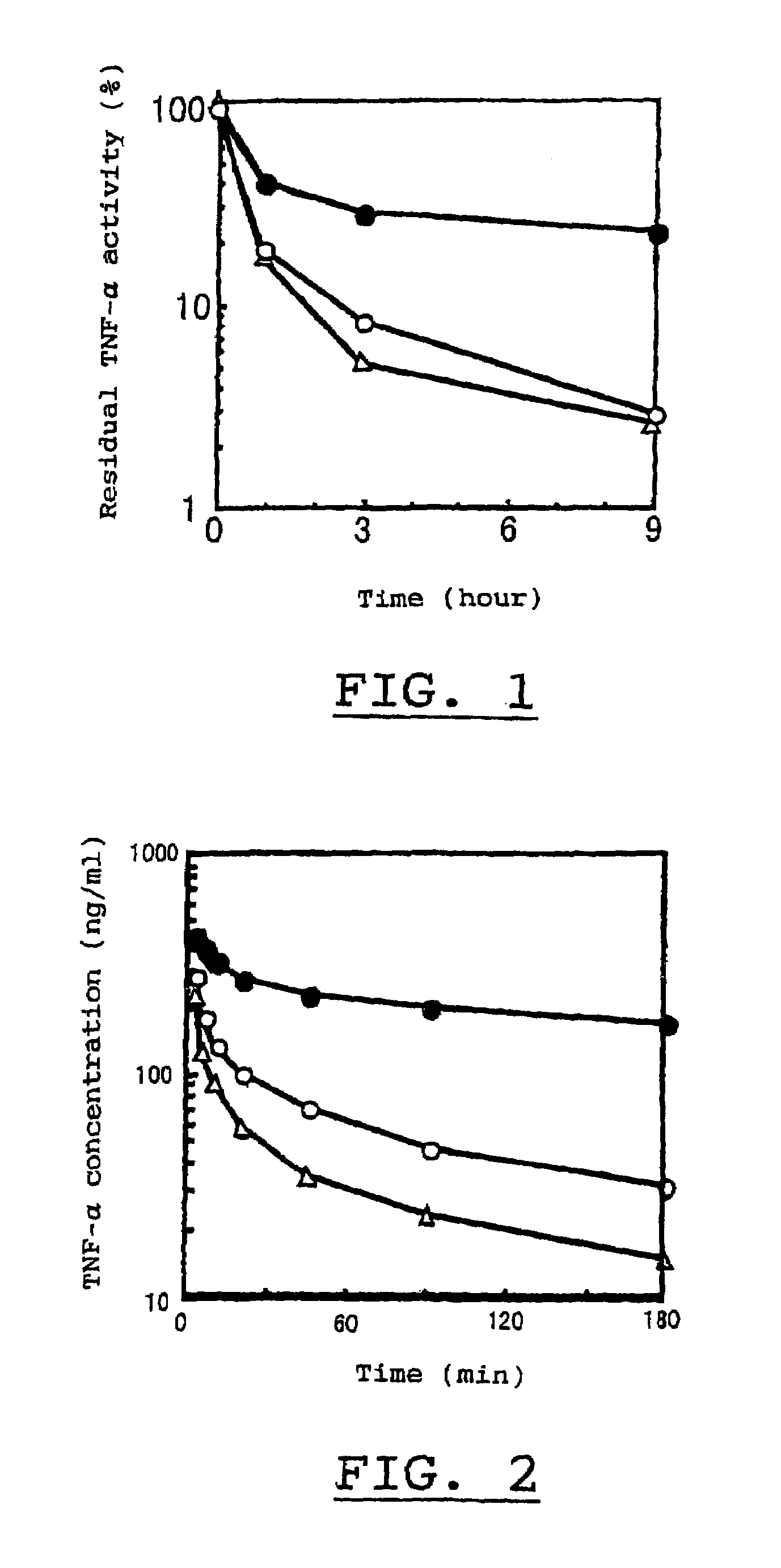Physiologically active complex
a technology of complexes and complexes, applied in the field of new physiologically active substances, can solve the problems that tnf cannot be kept at the desired blood level for a relatively long time, and achieve the effect of improving the dynamics of living bodies
- Summary
- Abstract
- Description
- Claims
- Application Information
AI Technical Summary
Benefits of technology
Problems solved by technology
Method used
Image
Examples
example 1
Preparation of Protein with TNF Activity
[0028]According to conventional manner, the oligonucleotides represented by SEQ ID NOs:4 and 5 as primers were subjected to PCR reaction with Taq polymerase at 60° C. The reaction mixture was purified to obtain a PCR product consisting of 162 base pairs where the 65th, 90th and 98th lysines in human TNF represented by SEQ ID NO:1 were replaced with random amino acids. In the presence of the oligonucleotides as primers represented by SEQ ID NOs: 6 and 7, the above PCR product was further subjected to PCR reaction with Taq polymerase at 60° C., and then the reaction mixture was purified to collect a PCR product consisting of 251 base pairs where the 65th, 90th, 98th, 112th, and 128th lysines in human TNF represented by SEQ ID NO:1 were all replaced with random amino acids.
[0029]While, according to conventional manner, a DNA encoding human TNF represented by SEQ ID NO:1 was introduced into a phagemid vector, “pCantab5e”, a trade name of and produ...
example 2
Preparation of Physiologically Active Complex
[0032]A protein having TNF activity, obtained by the method in Example 1, was dissolved in aqueous phosphate buffered saline (pH 8.5) to give a concentration of 0.1 to 1 mg / ml and admixed with methoxypolyethyleneglycol as a high molecular substance having an average molecular weight of 5,000 daltons, which had been activated by the addition of monomethoxypolyethyleneglycol-N-succinimidylpropionate in an amount of five times of the protein by molar ratio, followed by reacting the mixture at 37° C for 30 min. Thereafter, to the resulting mixture was added c-aminocaproic acid in an amount of 10-times of the high molecular substance by molar ratio and allowed to stand for a while before terminating the reaction. The reaction mixture was then purified by conventional method using gel filtration chromatography to obtain a homogeneous physiologically active complex in which polyethylene glycol bound to the N-terminus of a proteinaceous part of t...
example 3
Antitumor Action
[0034]According to usual manner, BALB / c female mice (4-weeks-old, 20 g weight each), which had been inoculated with meth A cells, ATCC 63181, a murine sarcoma, were divided into groups consisting of three heads per group and then injected into their tail veins with a physiological saline containing a physiologically active complex obtained by the method in Example 2, a protein with TNF activity obtained by the method in Example 1, or a recombinant human TNF at the doses in Table 1. At 24 hours after the administrations, the mice were examined for occurrence of hemorrhagic necrosis and sudden death, and measured for diameter of tumors at prescribed time intervals, followed by calculating the tumor volume according to the method described by Keisuke Haranaka in International Journal of Medicine , Vol. 34, pp. 263–267 (1984). The antitumor effects (%) of the samples tested were calculated by comparing the tumor volumes of the mice, received with the samples, with those ...
PUM
| Property | Measurement | Unit |
|---|---|---|
| molecular weight | aaaaa | aaaaa |
| molecular weight | aaaaa | aaaaa |
| temperature | aaaaa | aaaaa |
Abstract
Description
Claims
Application Information
 Login to View More
Login to View More - R&D
- Intellectual Property
- Life Sciences
- Materials
- Tech Scout
- Unparalleled Data Quality
- Higher Quality Content
- 60% Fewer Hallucinations
Browse by: Latest US Patents, China's latest patents, Technical Efficacy Thesaurus, Application Domain, Technology Topic, Popular Technical Reports.
© 2025 PatSnap. All rights reserved.Legal|Privacy policy|Modern Slavery Act Transparency Statement|Sitemap|About US| Contact US: help@patsnap.com



